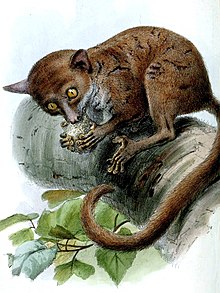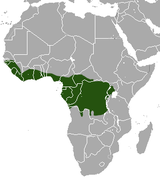Western dwarf galago
| Galagoides | |
|---|---|

| |
| Prince Demidoff's bushbaby (Gs. demidovii) | |
| Scientific classification | |
| Domain: | Eukaryota |
| Kingdom: | Animalia |
| Phylum: | Chordata |
| Class: | Mammalia |
| Order: | Primates |
| Suborder: | Strepsirrhini |
| Family: | Galagidae |
| Genus: | Galagoides A. Smith, 1833 |
| Species | |
|
Galagoides demidoff | |
The western dwarf galagos are a group of three species of strepsirrhine primates, native to western and central Africa. They are classified in the genus Galagoides of the family Galagidae. The eastern dwarf galagos (P. cocos, P. granti, P. orinus, P. rondoensis, and P. zanzibaricus) have been moved to their own genus, Paragalago, based on genetic evidence and differences in vocalization.[1] The two genera are not sister taxa and thus may have evolved their small sizes via parallel evolution. They are separated by the East African Rift.[1]
The first genus to be introduced to scientific literature was Galago by Geoffroy Saint-Hilaire. The genus was based on a smaller species from West Africa. Later, the genus Galagoides was introduced by Sir Andrew Smith in 1833. Smith wanted to differentiate the dwarf (Gd. demidovii) and the lesser galagos from the 'true galagos.' Otolemur was later introduced to indicate the greater galagos by Coquerel in 1859. Before the 21st century, three new dwarf galagos were recognized as species.[1][2]
The day-sleeping nests may be shared by groups of females or occasionally by visiting males.[3]
Galagoides species[edit]
| Common name | Scientific name and subspecies | Range | Size and ecology | IUCN status and estimated population |
|---|---|---|---|---|
| Angolan dwarf galago
|
G. kumbirensis Svensson et al., 2017 |
Angola in southwestern Africa
|
Size: 14–18 cm (6–7 in) long, plus 17–21 cm (7–8 in) tail[4] Habitat: Forest and shrubland[5] Diet: Unknown[4] |
NT
|
| Prince Demidoff's bushbaby | G. demidoff (Fischer von Waldheim, 1806) |
Western and central equatorial Africa
|
Size: 10–13 cm (4–5 in) long, plus 15–21 cm (6–8 in) tail[6] Habitat: Forest[7] Diet: Insects, as well as fruit and gum[6] |
LC
|
| Thomas's bushbaby
|
G. thomasi (Elliot, 1907) |
Western and central equatorial Africa
|
Size: 12–17 cm (5–7 in) long, plus 15–24 cm (6–9 in) tail[8] Habitat: Forest[9] Diet: Insects, as well as small vertebrates, fruit, and tree buds, leaves, and gum[8] |
LC
|
References[edit]
- ^ a b c Masters, J.C.; Génin, F.; Couette, S.; Groves, C.P.; Nash, S.D.; Delpero, M.; Pozzi, L. (2017). "A new genus for the eastern dwarf galagos (Primates: Galagidae)". Zoological Journal of the Linnean Society. 181 (1): 229–241. doi:10.1093/zoolinnean/zlw028. hdl:2318/1618044.
- ^ Génin, F.; Yokwana, A.; Kom, N.; Couette, S.; Dieuleveut, T.; Nash, S.D.; Masters, J.C. (2016). "A new galago species for South Africa (Primates: Strepsirhini: Galagidae)". African Zoology. 51 (3): 135–143. doi:10.1080/15627020.2016.1232602. S2CID 32920448.
- ^ Fleagle, John G. (1999). Primate adaptation and evolution. Academic Press. p. 114. ISBN 978-0-12-260341-9. Retrieved 10 July 2011.
- ^ a b Svensson, M. S.; Bersacola, E.; Mills, M. S. L.; Munds, R. A.; Nijman, V.; Perkin, A.; Masters, J. C.; Couette, S.; Nekaris, K. A.-I.; Bearder, S. K. (2017). "A giant among dwarfs: a new species of galago (Primates: Galagidae) from Angola". American Journal of Physical Anthropology. 163 (1): 30–43. doi:10.1002/ajpa.23175. PMID 28224607.
- ^ a b Svensson, M.; Bersacola, E.; Nijman, V.; Mills, S. L.; Munds, R.; Perkin, A.; Bearder, S. (2020). "Galagoides kumbirensis". IUCN Red List of Threatened Species. 2020: e.T164378198A164378551. doi:10.2305/IUCN.UK.2020-2.RLTS.T164378198A164378551.en.
- ^ a b Sampson, Christie (2004). "Galago demidoff". Animal Diversity Web. University of Michigan. Retrieved June 25, 2023.
- ^ a b Svensson, M.; Bersacola, E.; Bearder, S. (2019). "Galagoides demidoff". IUCN Red List of Threatened Species. 2019: e.T40649A17962255. doi:10.2305/IUCN.UK.2019-3.RLTS.T40649A17962255.en.
- ^ a b Phan, Jeremy (2009). "Galago thomasi". Animal Diversity Web. University of Michigan. Retrieved June 25, 2023.
- ^ a b Svensson, M.; Bearder, S. (2019). "Galagoides thomasi". IUCN Red List of Threatened Species. 2019: e.T40653A17962691. doi:10.2305/IUCN.UK.2019-3.RLTS.T40653A17962691.en.
External links[edit]
![]() Data related to Galagoides at Wikispecies
Data related to Galagoides at Wikispecies



